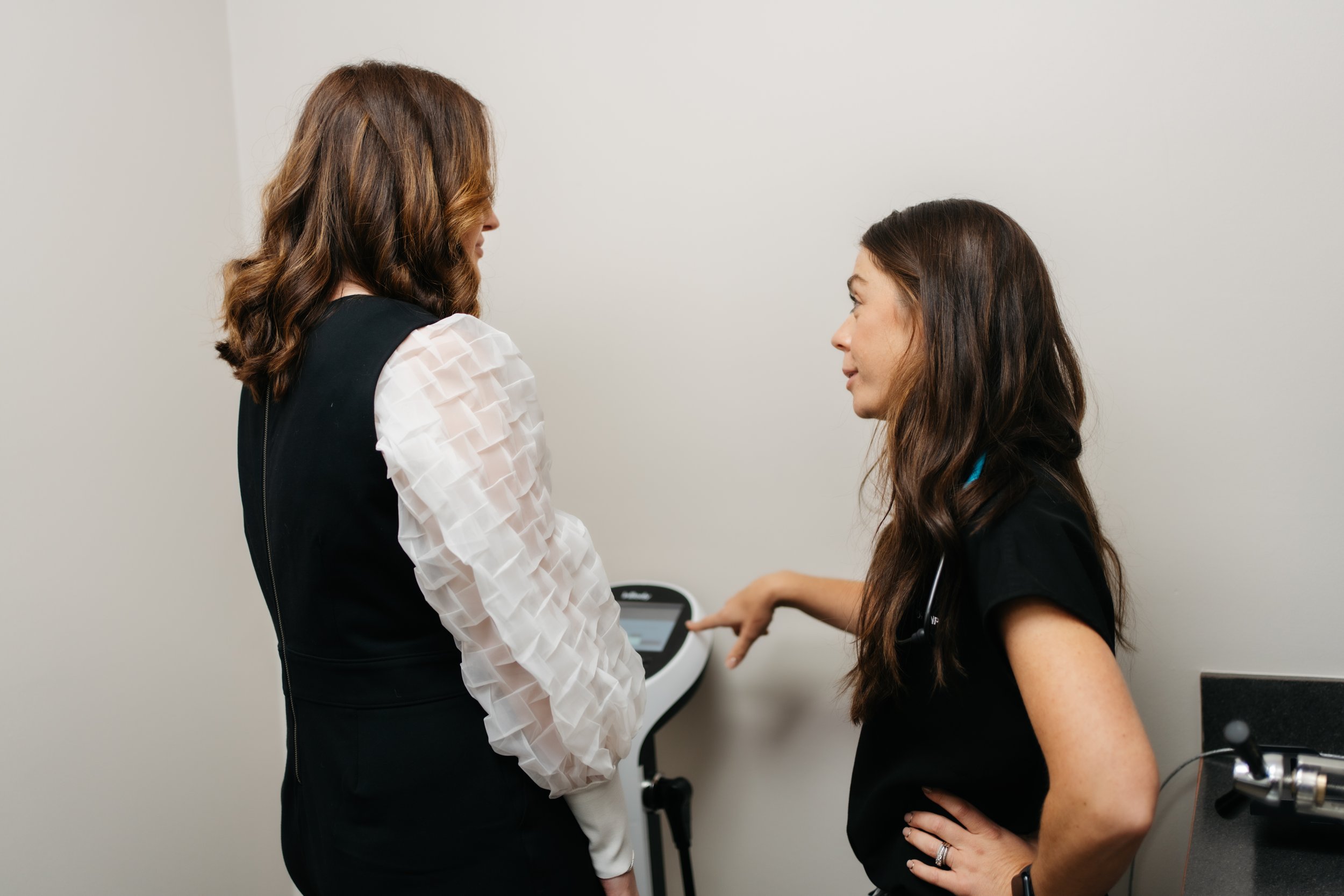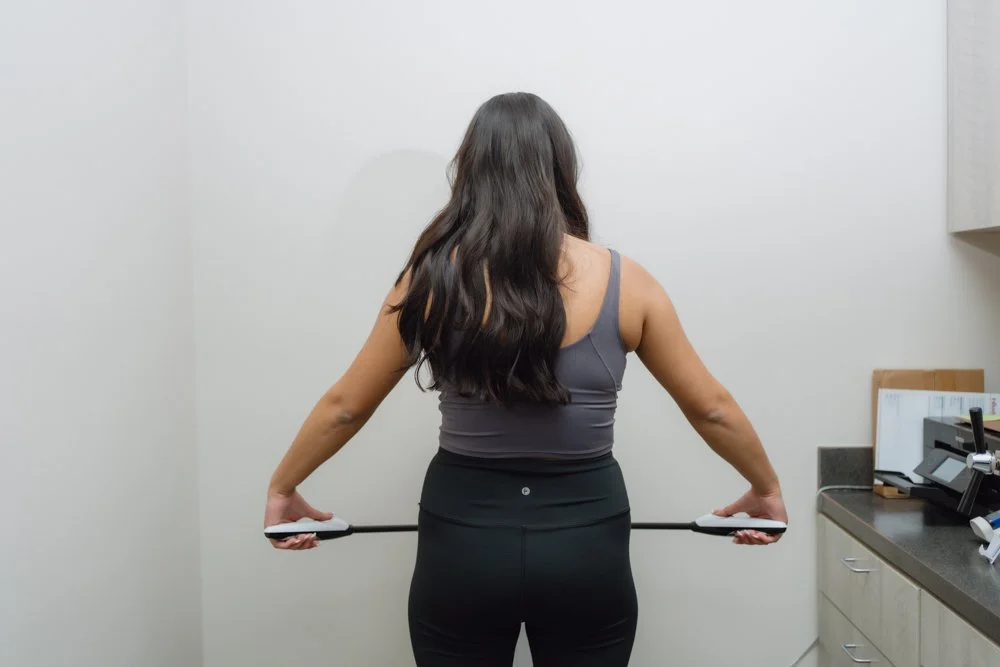
InBody Test in San Antonio - Precision Body Composition Analysis
How InBody Measures Muscle, Fat, and More in Seconds
Available for all Beauty Wise Patients
What is an Inbody Test?
InBody is an advanced body composition analyzer trusted by top hospitals, universities, and professional sports organizations. The InBody test is accurate, fast, and non-invasive – simply step on the device, grab the handles, and in 15 seconds, you will receive a detailed printout of your body composition results that you can review with our staff. Our InBody analysis will break down your body composition into the following:
Muscle Mass: InBody can accurately measure the amount of muscle mass in different regions of the body.
Body Fat Percentage: It assesses the percentage of body fat, helping individuals and professionals track changes in fat levels.
Water Content: InBody provides insights into the body’s water distribution, distinguishing between intracellular and extracellular water.
Basal Metabolic Rate (BMR): BMR is the number of calories the body needs to maintain basic functions at rest. InBody helps estimate this value.
Visceral Fat: This is the fat stored around internal organs and is associated with various health risks. InBody can measure visceral fat levels.
Bone Mineral Content: It assesses the bone mineral density, which is crucial for bone health.





Body composition is a method of breaking down your body into it’s core components: fat, muscle, & water. It gives you a more in-depth understanding of your weight and health, helps you track diet and exercise progress, and make any changes needed to meet your health goals.
Body Fat: Percent Body Fat or Body Fat Percentage is a more accurate indicator of your health than your body weight or BMI because it tells you exactly how much fat mass makes up your total body weight. For a healthy body fat level, aim for a PBF within 10 – 20% (for males) or 18 – 28% (for females).
BMR: Your Basal Metabolic Rate (BMR) is the number of calories you burn at rest.
Visceral Fat: Visceral fat is a special kind of belly fat that is hidden deep inside your abdomen and surrounds your inner organs. Unlike-surface level (subcutaneous) fat, it’s not easy to gauge how much visceral fat someone has just by looking at them.
Lean Mass: Segmented Lean Mass (SML) views the human body as five cylinders: left arm, right arm, left leg, right leg and the torso.
What is body composition?
Am I A Candidate for an Inbody Test?
Everyone is! This body composition test allows you to see where your body composition is as well as helps you track your fitness and health journey along the way.
There are two instances were we DO NOT recommend the InBody Test:
We do recommend people with artificial electrical implants such as a defibrillator or pacemaker are not recommended to take an InBody Test. The electrical currents of the InBody may disrupt the functionality of life-sustaining implants.
Women who are on their menstrual cycle or are pregnant are not recommended to test as they may not obtain accurate results due to subtle changes in their hydration and body water levels.
What is body composition analysis important?
Body composition is a more accurate measure of your weight and health than BMI because it divides your weight into fat, muscle, and water. It tells you exactly what you are losing, gaining, or maintaining. With body composition analysis, you can measure your fat and muscle mass, track your progress, and make any changes needed to meet your goals.

How to prep for your inBody Test
Follow these simple steps before your InBody Test to ensure consistent testing conditions and the most accurate results:
Do:
maintain your normal fluid intake the day before
stand upright for at least 5 minutes
remove any socks or pantyhose
remove all heavy accessories like jewelry, watches, and jackets
warm yourself up for 20 minutes in cold weather
use the restroom
Don’t:
eat or exercise for at least 3 hours
consume alcohol or excess caffeine for at least 24 hours
shower or use a sauna
use lotion or ointment on your hands and feet
How Does an InBody Test Work?
An InBody analysis works on the principle of bioelectrical impedance analysis (BIA). Here’s how it works:
Electrode Placement: During an InBody analysis, you will stand on the InBody device, which has electrodes on the handles and footplates. Electrode pads are typically placed on the palms and soles.
Low-Level Electrical Current: The InBody device sends a safe, low-level electrical current through the body. This current is imperceptible and does not cause any discomfort.
Measurement of Electrical Impedance: As the electrical current travels through your body, it encounters different tissues such as muscle, fat, and bone. These tissues have varying levels of electrical conductivity.
Analysis of Impedance: The InBody device measures the impedance or resistance encountered by the electrical current as it passes through your body. Muscle tissue, which contains more water and is highly conductive, allows the current to pass more easily, while fat tissue, which contains less water, offers greater resistance.
Body Composition Calculation: Using the impedance data and your height, weight, and age, the InBody device calculates various body composition parameters. These may include muscle mass, body fat percentage, water content, visceral fat, bone mineral content, and more.
Results Display: The results are typically displayed on the device’s screen or provided in a printed report. This report provides a detailed breakdown of your body composition and often includes recommendations for fitness and nutrition based on the data.
It’s important to note that InBody analyses are non-invasive, quick, and safe. The accuracy of the results depends on factors such as proper electrode placement and hydration levels. To obtain the most accurate readings, we usually advise to avoid eating or drinking for a few hours before the analysis and to ensure that their skin is clean and dry to allow for better electrical conductivity.
Benefits of an InBody Test:
Accurate Body Composition Assessment: InBody provides a precise measurement of body composition, including muscle mass, body fat percentage, visceral fat, water content, and bone mineral content. This information can be crucial for individuals seeking to manage their weight, improve fitness, or monitor their health.
Customized Health and Fitness Guidance: InBody results are often accompanied by personalized recommendations for nutrition and exercise. These recommendations are based on the individual’s specific body composition and can help them set realistic health and fitness goals.
Tracking Progress: InBody analyses can be performed periodically to track changes in body composition over time. This is valuable for individuals working towards weight loss, muscle gain, or other fitness goals, as it allows them to assess the effectiveness of their efforts.
Identifying Health Risks: In addition to body composition data, InBody may provide insights into potential health risks. For example, high visceral fat levels are associated with an increased risk of certain health conditions like heart disease and diabetes. Identifying such risks early can motivate individuals to make positive lifestyle changes.
Motivation and Accountability: Knowing your body composition and seeing how it changes can be highly motivating. It provides a tangible way to measure progress and can encourage individuals to stay committed to their health and fitness routines.
Individualized Nutrition Plans: InBody analyses can help dietitians and nutritionists create personalized nutrition plans tailored to an individual’s unique needs and goals.
Clinical Applications: InBody analyses are used in medical settings to assess and monitor conditions like edema (excess fluid retention), malnutrition, and muscle atrophy. They can also aid in the management of chronic diseases.
Quick and Non-Invasive: InBody assessments are fast and non-invasive. They can be performed in a matter of minutes and do not require blood tests or other invasive procedures.
Objective Feedback: InBody provides objective data, reducing the reliance on subjective assessments like body weight or appearance. This can lead to more informed decision-making regarding health and fitness.
How to Read your InBody Result Sheet:
Hover over different parts of the InBody Result Sheet to get a brief overview of what each body composition output means. Everything you need to know to interpret InBody Results and start offering your clients the insights they need to improve their health & wellness.
The Science behind InBody Analysis:
InBody analysis relies on Bioelectrical Impedance Analysis (BIA) technology. It works by sending a safe, low-level electrical current through the body. This current encounters resistance as it passes through different tissues, primarily influenced by water and electrolyte content. InBody devices use mathematical algorithms to calculate body composition components, such as muscle mass, body fat percentage, visceral fat, total body water, bone mineral content, and basal metabolic rate. The results are displayed on the device, providing a comprehensive view of an individual’s health and fitness. InBody analysis is a precise and non-invasive method, making it a valuable tool for health assessments and goal setting.



